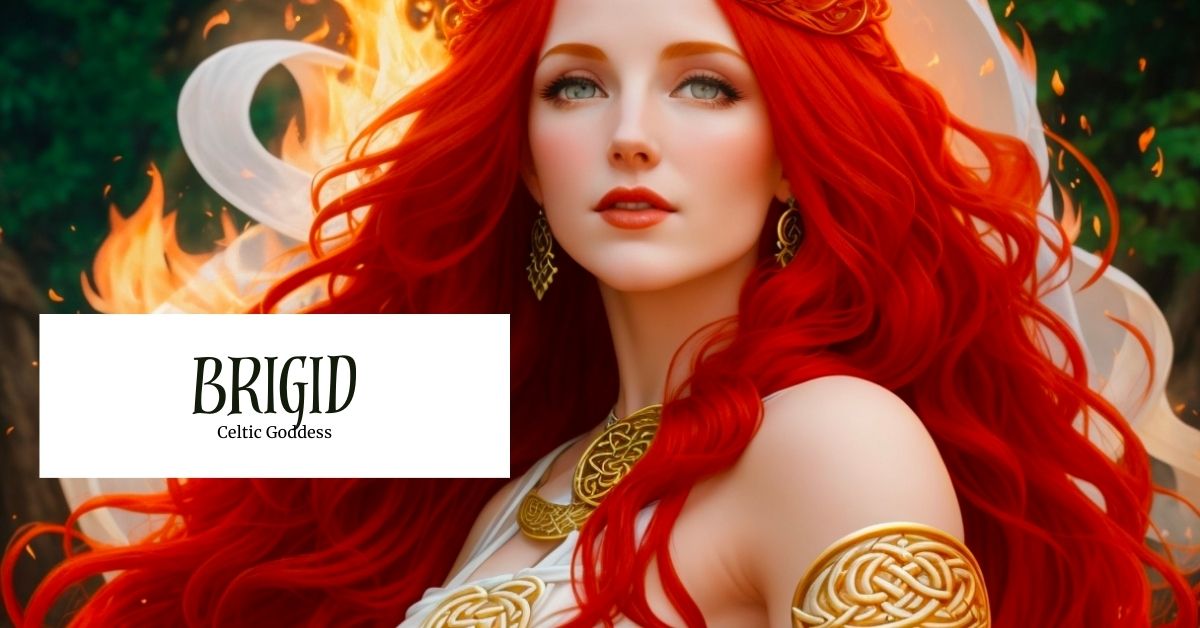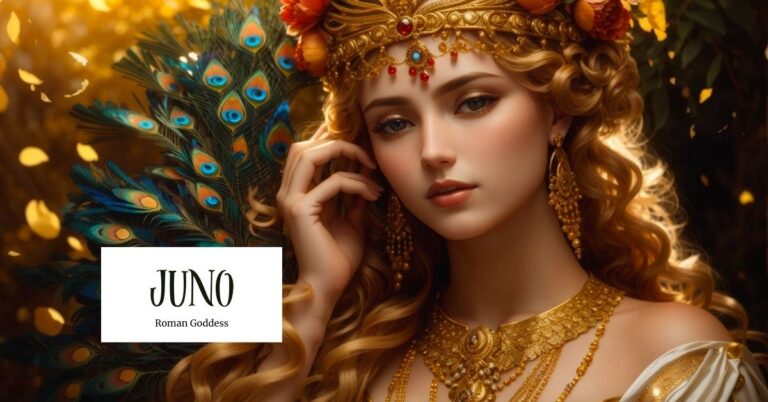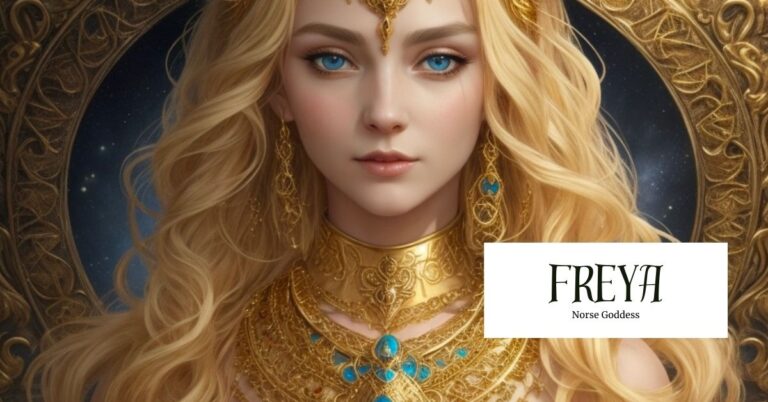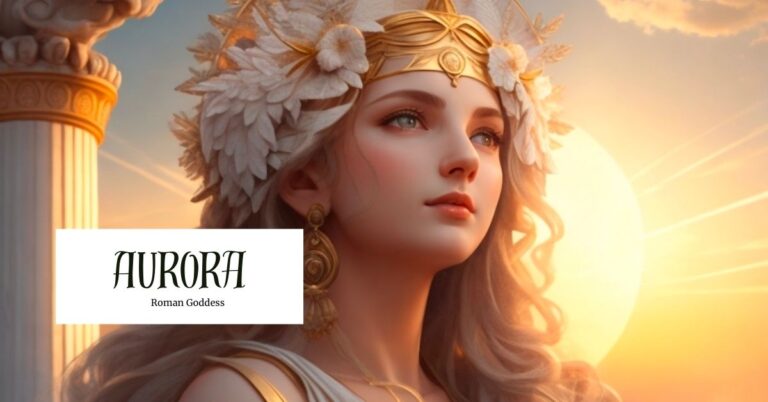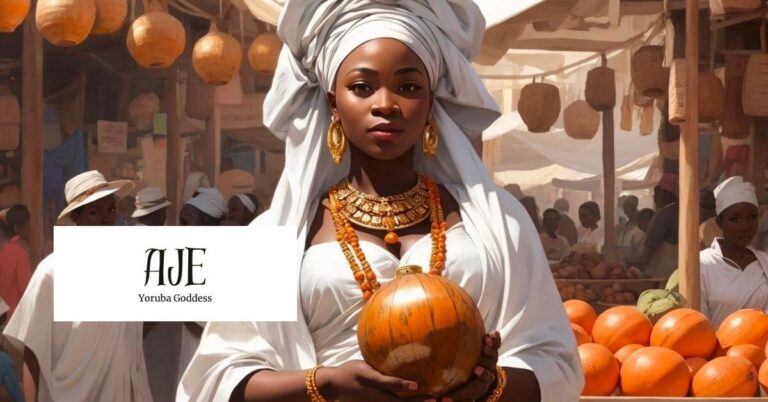Brigid: Triple Goddess of Healing, Poetry, and Smithing
While deities and gods have been praised and worshiped, the ethereal presence of goddesses stands out as an embodiment of the divine feminine. Goddesses have long fascinated cultures across the globe, serving as symbols of power, creativity, and wisdom. These iconic figures transcend time, reflecting the multifaceted nature of women and inspiring generations with their strength and grace.
In mythologies worldwide, goddesses hold significant roles as both creators and destroyers, nurturers and warriors, of love and agents of justice. They personify the elements, govern natural phenomena, and represent the cycles of life, death, and rebirth. From the fierce warrior goddess Athena of ancient Greece to the nurturing mother goddess Isis of ancient Egypt, each deity carries a distinct set of attributes, that resonate with aspects of human experience.
The worship of goddesses extends beyond mythology, expanding cultures throughout history. Goddess spirituality movements, such as the revival of ancient goddess traditions and the rise of modern goddess-centered spirituality, have become more popular. These movements aim to reclaim the divine feminine, seeking to restore balance in a world often dominated by patriarchal systems. We can see how the goddess Brigid has cultivated the sacred feminine throughout her history.
Overview of Brigid
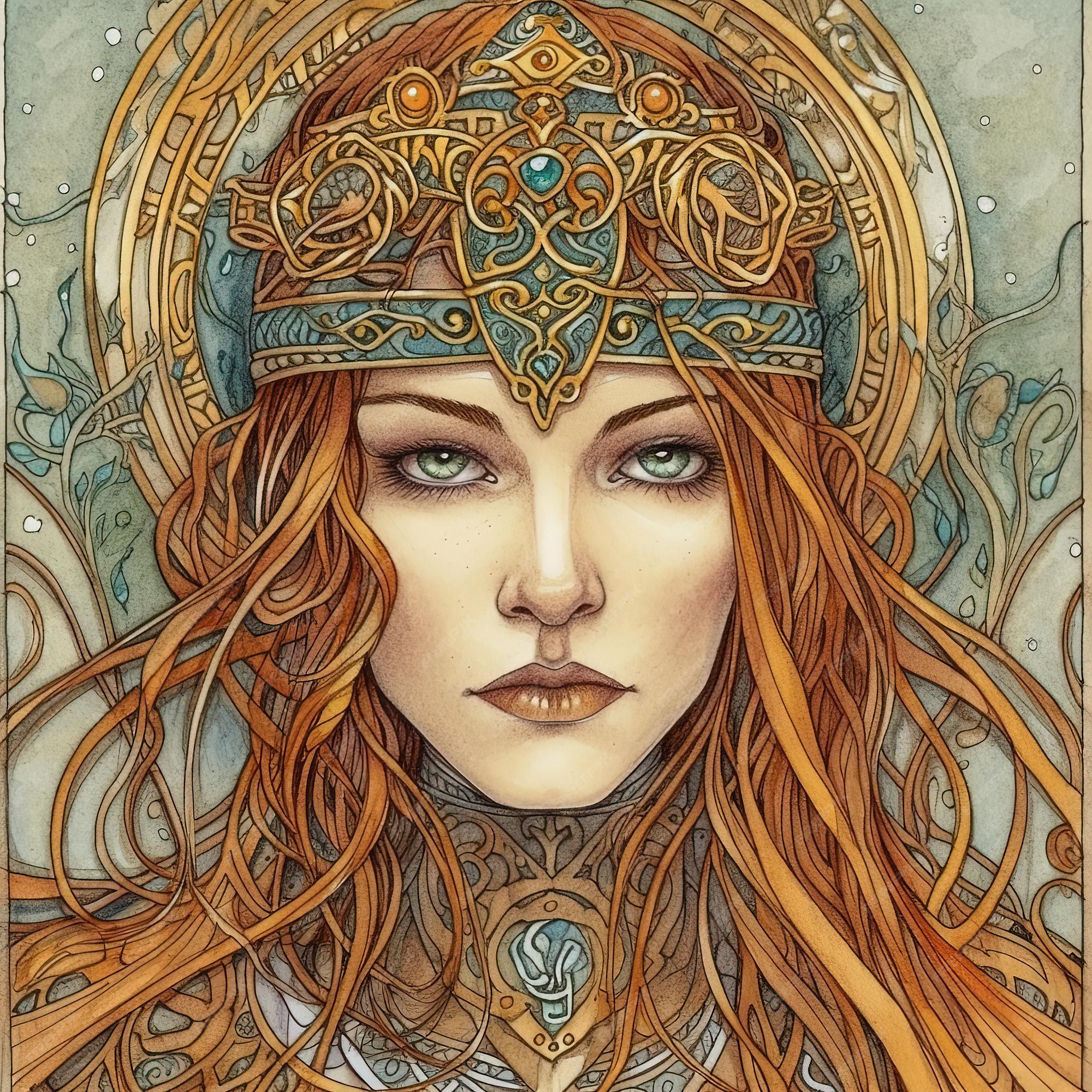
Source: FreePik
The goddess Brigid can be known as “the fiery arrow,” which recalls a similar symbolism to Artemis. Her red hair depicts fire-like traits ad she is the goddess of fire (Waldherr, Kris. The Book of Goddesses: Expanded Anniversary Edition). Brigid is one of the triple goddesses. Triple goddesses have three different abilities and are likely believed as three goddesses in one. For Brigid, they are healing, poetry, and smith craft. While she is the goddess of those three, she possesses abilities of sacred fire and bringing harvests.
There is debate whether she is three separate goddesses known as Brigid or three-in-one. She can also go by the name Briginita or “high one” (Monaghan PhD, Patricia. Encyclopedia of Goddesses and Heroines). Brigid has been related to the female take on the creator of nature or mother nature. In her prime, poets would call upon Brigid for a spark of inspiration, and she can often be seen as a white swan as they take the same meaning.
Titles
- High One
- Bride
- Brignita
- The Great Mother
- The Fiery Arrow
Abilities
Brigid is known as a goddess of fire or the sun goddess. Her triple goddess abilities can have a fiery type passion within poetry, healing, and smith craft. Poets have begged her to possess them so that they may write poetry articulate and beautiful, like hers. Her words were known to invoke emotional reactions from people as they heard them.
It was common to call on Brigid for a spark of inspiration using her sacred flame. Furthermore, Brigid is the one who taught humans how to heal with natural substances from the earth and forge from iron (Waldherr, Kris. The Book of Goddesses: Expanded Anniversary Edition). Her skilled hands wield the hammer and anvil with masterful precision, forging weapons and tools that embody both strength and purpose.
Beyond these primary abilities, Brigid is also known as a guardian of sacred flames. She tends to eternal fires, keeping the hearth aglow and protecting communities from harm. Her influence extends to matters of divination and prophecy, as she holds the wisdom to unveil hidden truths and guide seekers along their paths (Monaghan PhD, Patricia. Encyclopedia of Goddesses and Heroines).
Characteristics
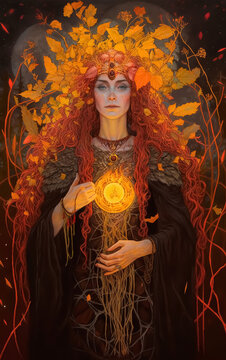
Source: Adobe Stock
Brigid is depicted looking like a traditional Celtic woman. With flowing auburn hair cascading down her shoulders, Brigid emanates an ethereal glow, casting a warm and comforting light. Her eyes, the color of sapphire seas, sparkle with both wisdom and a mischievous spark, hinting at her multifaceted nature.
Whether she is depicted as a graceful goddess in the midst of harvest or a goddess demanding the power she deserves, she is never far from beautiful. She can often be seen in a white dress, strolling through the woods as she revives what has died over the winter.
Oftentimes her delicate hands can be seen holding a sacred and eternal flame. This flame, a testament to her association with sacred fire and transformation, dances gracefully, as if in harmony with her every movement. Brigid’s appearance encapsulates the majesty and grace of the divine feminine, captivating all who behold her. She stands as a radiant symbol of inspiration, inviting humanity to embrace their own inner strength, creativity, and healing power.
Traits
Goddess Brigid possesses a personality as vibrant and a variety of all. She embodies a blend of strength, compassion, and creativity, captivating all who meet her with her radiant spirit. While Brigid’s power is awe-inspiring, her heart brims with compassion and tenderness.
She is the embodiment of the nurturing mother, offering solace and guidance to those in need. But do not think that her motherly nature inhibits her from fully embracing her goddess powers. Beneath her serene exterior lies a fierce determination that resonates with the fiery depths of her being. Brigid is a guardian and protector, fiercely defending the weak and vulnerable from harm.
Creativity dances within Brigid’s essence, and she revels in the arts and encourages mortals to explore their own creative potential. She embraces the beauty of self-expression, nurturing the creative spark within each individual and guiding them to unlock their unique gifts.
Symbols

Source: FreePik
Cattle, water, and fire serve as powerful symbols that intertwine with the essence of the goddess Brigid, highlighting her influence and the depth of her connection to the natural world (Monaghan PhD, Patricia. Encyclopedia of Goddesses and Heroines).
Cattle, symbols of plenty and prosperity, hold a special place within Brigid’s realm. Known as the protector of livestock, she watches over the gentle creatures with a tender care. The symbolism of cattle also extends to the concept of wealth and material prosperity, highlighting Brigid’s role as a provider and sustain of earthly abundance.
Water, flowing in rivers, springs, and wells, carries the life-giving essence that echoes Brigid’s nurturing nature. It represents purification, healing, and renewal. Brigid’s association with water reflects her ability to cleanse the spirit and rejuvenate the soul. Her presence is felt in the gentle rhythm of babbling brooks and the cascading rush of waterfalls. Water also symbolizes the fluidity of emotions and the power of intuition, qualities that Brigid imparts upon those who seek her guidance. Water is a primary symbol of Danu with her connection to the river Danube, Yoruban goddess Oba, and the Egyptian goddess Tefnut.
Fire, perhaps the most iconic symbol associated with Brigid, represents her association with the sacred and eternal flame (Liz Turnbull, Brigid: Celtic Goddess Of Fire). As the guardian of the hearth, Brigid tends to the eternal fire, ensuring its perpetual burning, recalling the goddess Vesta of the hearth and home. The flame serves as a beacon of warmth, light, and protection, symbolizing transformation, inspiration, and purification. The fiery element also mirrors her fierce spirit and the passion she ignites within hearts. Through cattle, water, and fire, Brigid’s influence touches the realms of spirituality, and personal growth, inviting all who meet her.
Festivals and Rituals
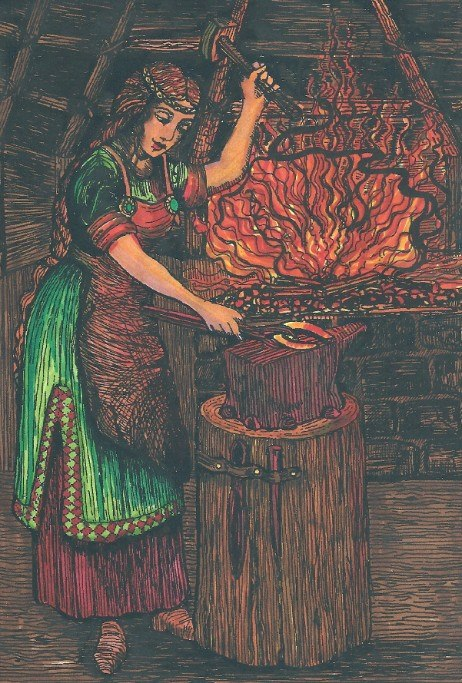
Source: The Green Man Store
Goddess Brigid is honored through vibrant festivals and rich rituals that celebrate her essence as a guardian of fire, inspiration, healing, and the arts. On the first of February, a festival is dedicated to Brigid (Monaghan PhD, Patricia. Encyclopedia of Goddesses and Heroines). Imbloc marks the end of winter and the anticipation of the forthcoming season of growth.
Communities gather in fields adorned with snowdrops and daffodils, offering prayers and gratitude to Brigid for the promise of renewal. As dawn breaks, participants light countless candles, symbolizing the return of the sun’s warmth and the illuminating power of Brigid’s divine flame. This act serves as both a physical and spiritual purification, as the light banishes the remnants of darkness and ushers in a new era of possibilities.
People weave intricate Brigid’s crosses from rushes, a traditional craft believed to bring protection and blessings to homes. These crosses, symbolizing Brigid’s role as a guardian, are hung above doorways to ward off negative energies and invite her benevolent presence.
Legends associated with Brigid
While Brigid is known to have eternal life she must come from somewhere. Like most people, this fire Goddess has parents and stories about where she came from.
Origin story
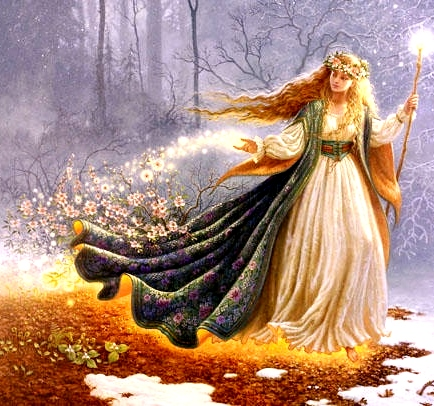
Source: Dark Emerald Tales
This Irish Goddess is believed to be the daughter of the revered god Dagda, a figure associated with fertility, abundance, and wisdom, and his wife Bres (Waldherr, Kris. The Book of Goddesses: Expanded Anniversary Edition). Brigid inherits her father’s divine lineage and his connection to the natural world.
Brigid’s role as a healing goddess is deeply intertwined with her association with fire. In Celtic tradition, fire was believed to have purifying and regenerative qualities. Brigid’s healing powers extend to physical, emotional, and spiritual realms. She is invoked to aid in the mending of ailments, the soothing of troubled minds, and the fostering of well-being.
The precise nature of Brigid’s origins remains a subject of speculation. Some interpretations suggest that her worshipers revered three separate goddesses named Brigit, each with her own distinct domain, while others propose that she may have been viewed as one goddess embodying the diverse aspects of healing, smith craft, and poetry (Monaghan PhD, Patricia. Encyclopedia of Goddesses and Heroines).
As Brigid’s story unfolds, she emerges as a beacon of divine wisdom, an embodiment of feminine power, and a guardian of sacred traditions. Her origins, entwined with the lineage of gods and the landscapes of Ireland, evoke a sense of awe and admiration. Whether as a deity in ancient Celtic myth or as a revered saint in Catholicism, Brigid’s enduring presence continues to inspire and uplift those who recognize the interconnectedness of the healing arts, the creative spirit, and the power of words.
Brigid Goddess is known to be a part of Tuatha Dé Danann. Tuatha Dé Danann is a supernatural community in Ireland before the modern Irish arrived. They have been related to having fairy like qualities and while the Celtic Goddess Brigid is not a fairy she does possess nymph like qualities.
The Sacred Wells

Source: Druidry
In Celtic mythology, there is a beautiful legend surrounding the goddess Brigid and her sacred wells. According to the tale, Brigid’s well was located in the heart of a lush green meadow, hidden from mortal eyes by a shimmering veil of magic.
It was said that this sacred well held extraordinary healing properties. People who were sick or in need of spiritual guidance would make a pilgrimage to the well, seeking Brigid’s blessings and the waters of rejuvenation. It was believed that by drinking from the well or bathing in its waters, one could be cured of ailments, find inspiration, or receive answers to their prayers. It became a symbol of Brigid’s benevolence and the power of faith (Liz Turnbull, Brigid: Celtic Goddess Of Fire).
Prisoner Bride
According to ancient stories, once held Bride, a radiant figure synonymous with the goddess Brigid, captive within the lofty peaks. In this enchanting tale, Bride’s son, captivated by the ethereal beauty of the imprisoned girl. Undeterred by the ferocious elements, Bride and her beloved pressed on, their love serving as an unwavering beacon of hope.
Finally, in a climactic moment, as the storm reached its crescendo, the Cailleach, consumed by her own anger, was transformed into a statue of stone (Monaghan PhD, Patricia. Encyclopedia of Goddesses and Heroines). Her malevolent powers shattered, the shackles that held Bride in captivity were broken, and she emerged, free at last from her prison.
With the liberation of Brigid, the winds softened, and the biting chill gave way to the gentle caress of a spring. The mountains, once cloaked in the harsh grip of winter’s embrace, bloomed with the vibrant hues of rebirth and renewal. Nature itself rejoiced, as the goddess Brigid, in her radiant form, became a symbol of hope, transformation, and the triumphant power of love (Monaghan PhD, Patricia. Encyclopedia of Goddesses and Heroines).
Influences of other religions on Brigid
The stories of the Irish Goddess Brigid’s powers and influence captivated the hearts of the nuns, who saw in her a figure of immense compassion, healing, and inspiration (Monaghan PhD, Patricia. Encyclopedia of Goddesses and Heroines). Over time, the respect of Brigid as a pagan goddess and as an Irish Christian Saint became entwined, their celebrations merging into one harmonious tapestry of devotion.
The rituals, symbols, and festivities associated with both the goddess and the saint found common ground, blending seamlessly to create a shared celebration that transcended the boundaries of faith and tradition. The recognition of Brigid as a saint solidified her place in the Catholic pantheon, with Saint Brigid, or Bridget, becoming one of the cherished figures of Irish spirituality.
For centuries, the people of Ireland celebrated the feast day of the Christian saint, marked by rituals that honored her as a patroness of healing, inspiration, and creativity. Nevertheless, the celebrations and traditions associated with Brigid, whether as a goddess or as a saint, continued to endure and thrive.
Modern appearances of Brigid
Brigid appeared in the Fire Emblem: Three Houses game not as the goddess herself, but instead a namesake to a neighboring country. However, many influences of Celtic mythology can be found in that game from names of characters and places to religious holidays.
If you have seen other modern appearances of her, please do let us know!
Final thoughts
The goddess Brigid holds a significant place in Celtic mythology and continues to be revered and celebrated to this day. Her multifaceted nature as a healer, poet, and smith embodies the essence of various aspects of life. As a healer, she provides solace and restores well-being, while as a patroness of poetry, she inspires creativity and the power of words. Her association with smith craft signifies the transformative power and skillful craftsmanship.
Brigid’s enduring presence serves as a reminder of the profound impact of her influence on Celtic culture and spirituality, making her a beloved and revered figure in the pantheon of gods and goddesses.
Sources
Waldherr, Kris. The Book of Goddesses: Expanded Anniversary Edition (pp. 108-109). Art and Words Editions. Kindle Edition.
Monaghan PhD, Patricia. Encyclopedia of Goddesses and Heroines (pp. 181-182). New World Library. Kindle Edition.
Marija Gimbutas. The Living Goddesses (pp. 186-187). Kindle Edition.
Monica Sjöö and Barbara Mor, The Great Cosmic Mother

